mark sanger
Established Member
- Joined
- 2 Jan 2009
- Messages
- 1,224
- Reaction score
- 0
Hi all
This piece I have been working on for a while. It has taken some time as I could not make the finial as fine as I wanted out of wood and until I started playing with polymer clay could not realise the design.
There is much behind this piece with references to various Japanese philosophies.
Keeping it short this piece is reflective of my research carried out within the tea Ceremony and at the time before a chap called Rikyu changed the way it was seen.
Prior to Rikyu the tea ceremony was a very elaborate prestigious, elitist ritual where by the utensils were very elaborately made, highly polished, including metal/gold etc.
When Rikyu came along he strip it all away and changed it to a much more simpler system using natural materials such as bamboo for the utensils. Despite him upsetting his Master who thought he was challenging his authority and demanded Rikyu's suicide. Poor chap.
Anyway this piece is a reflection of the time before Rikyu and how everything is impermanent and eventually rots/returns to its original state. Even the highly polished and revered falls to this eventually.
This piece aged to show this decaying. 150mm dia x 150mm high
Sycamore. Stained using artists pigments.
Gold leaf, copper leaf,
polymer clay,
brass bead
Various techniques.
sat on a slate plinth.
Comments welcome.

This piece I have been working on for a while. It has taken some time as I could not make the finial as fine as I wanted out of wood and until I started playing with polymer clay could not realise the design.
There is much behind this piece with references to various Japanese philosophies.
Keeping it short this piece is reflective of my research carried out within the tea Ceremony and at the time before a chap called Rikyu changed the way it was seen.
Prior to Rikyu the tea ceremony was a very elaborate prestigious, elitist ritual where by the utensils were very elaborately made, highly polished, including metal/gold etc.
When Rikyu came along he strip it all away and changed it to a much more simpler system using natural materials such as bamboo for the utensils. Despite him upsetting his Master who thought he was challenging his authority and demanded Rikyu's suicide. Poor chap.
Anyway this piece is a reflection of the time before Rikyu and how everything is impermanent and eventually rots/returns to its original state. Even the highly polished and revered falls to this eventually.
This piece aged to show this decaying. 150mm dia x 150mm high
Sycamore. Stained using artists pigments.
Gold leaf, copper leaf,
polymer clay,
brass bead
Various techniques.
sat on a slate plinth.
Comments welcome.

































